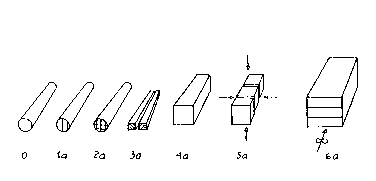Some of the information on this Web page has been provided by external sources. The Government of Canada is not responsible for the accuracy, reliability or currency of the information supplied by external sources. Users wishing to rely upon this information should consult directly with the source of the information. Content provided by external sources is not subject to official languages, privacy and accessibility requirements.
Any discrepancies in the text and image of the Claims and Abstract are due to differing posting times. Text of the Claims and Abstract are posted:
| (12) Patent Application: | (11) CA 2095846 |
|---|---|
| (54) English Title: | MEANS FOR SAWING ELONGATE UNITS FROM A TREE-TRUNK |
| (54) French Title: | TECHNIQUE DE SCIAGE D'UN GRUME POUR L'OBTENTION DE PIECES ALLONGEES |
| Status: | Deemed Abandoned and Beyond the Period of Reinstatement - Pending Response to Notice of Disregarded Communication |
| (51) International Patent Classification (IPC): |
|
|---|---|
| (72) Inventors : |
|
| (73) Owners : |
|
| (71) Applicants : |
|
| (74) Agent: | SWABEY OGILVY RENAULT |
| (74) Associate agent: | |
| (45) Issued: | |
| (86) PCT Filing Date: | 1991-11-06 |
| (87) Open to Public Inspection: | 1992-05-09 |
| Availability of licence: | N/A |
| Dedicated to the Public: | N/A |
| (25) Language of filing: | English |
| Patent Cooperation Treaty (PCT): | Yes |
|---|---|
| (86) PCT Filing Number: | PCT/SE1991/000748 |
| (87) International Publication Number: | SE1991000748 |
| (85) National Entry: | 1993-05-07 |
| (30) Application Priority Data: | ||||||
|---|---|---|---|---|---|---|
|
2095846 9208587 PCTABS00013
Retaining the correct shape is difficult when two or more
elongate units are obtained from a dried tree-trunk and joined together.
This difficulty is avoided by using damp timber which is sawn
into units, two or more units being joined together using a glue
that requires moisture in order to cure. Units joined together are
tied tightly before the drying process.
Note: Claims are shown in the official language in which they were submitted.
Note: Descriptions are shown in the official language in which they were submitted.

2024-08-01:As part of the Next Generation Patents (NGP) transition, the Canadian Patents Database (CPD) now contains a more detailed Event History, which replicates the Event Log of our new back-office solution.
Please note that "Inactive:" events refers to events no longer in use in our new back-office solution.
For a clearer understanding of the status of the application/patent presented on this page, the site Disclaimer , as well as the definitions for Patent , Event History , Maintenance Fee and Payment History should be consulted.
| Description | Date |
|---|---|
| Inactive: IPC from MCD | 2006-03-11 |
| Inactive: IPC from MCD | 2006-03-11 |
| Inactive: IPC from MCD | 2006-03-11 |
| Inactive: Reversal of dead status | 1998-04-03 |
| Time Limit for Reversal Expired | 1997-11-06 |
| Time Limit for Reversal Expired | 1997-11-06 |
| Deemed Abandoned - Failure to Respond to Maintenance Fee Notice | 1997-11-06 |
| Application Not Reinstated by Deadline | 1997-11-06 |
| Deemed Abandoned - Failure to Respond to Maintenance Fee Notice | 1996-11-06 |
| Deemed Abandoned - Failure to Respond to Maintenance Fee Notice | 1996-11-06 |
| Application Published (Open to Public Inspection) | 1992-05-09 |
| Abandonment Date | Reason | Reinstatement Date |
|---|---|---|
| 1997-11-06 | ||
| 1996-11-06 | ||
| 1996-11-06 |
Note: Records showing the ownership history in alphabetical order.
| Current Owners on Record |
|---|
| TRAFORM AB |
| Past Owners on Record |
|---|
| JERKER BRANDT |
| LENNART HELLBERG |